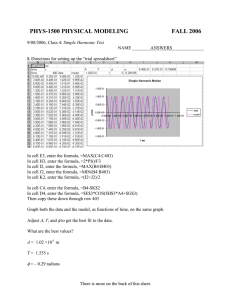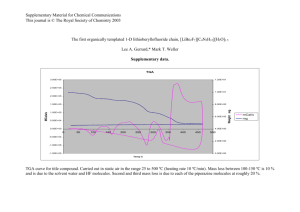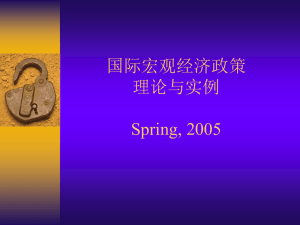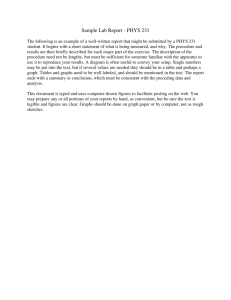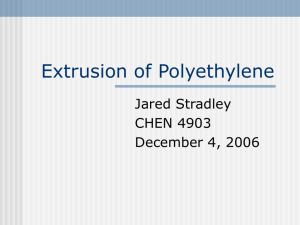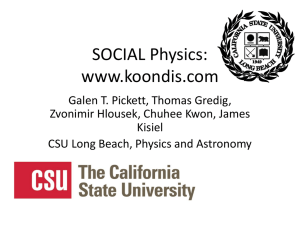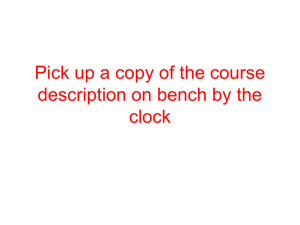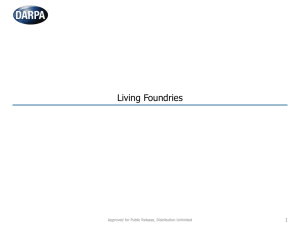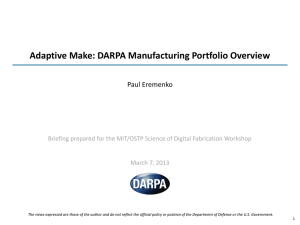Atmospheric Chemistry: CHEM-5151 / ATOC-5151
advertisement
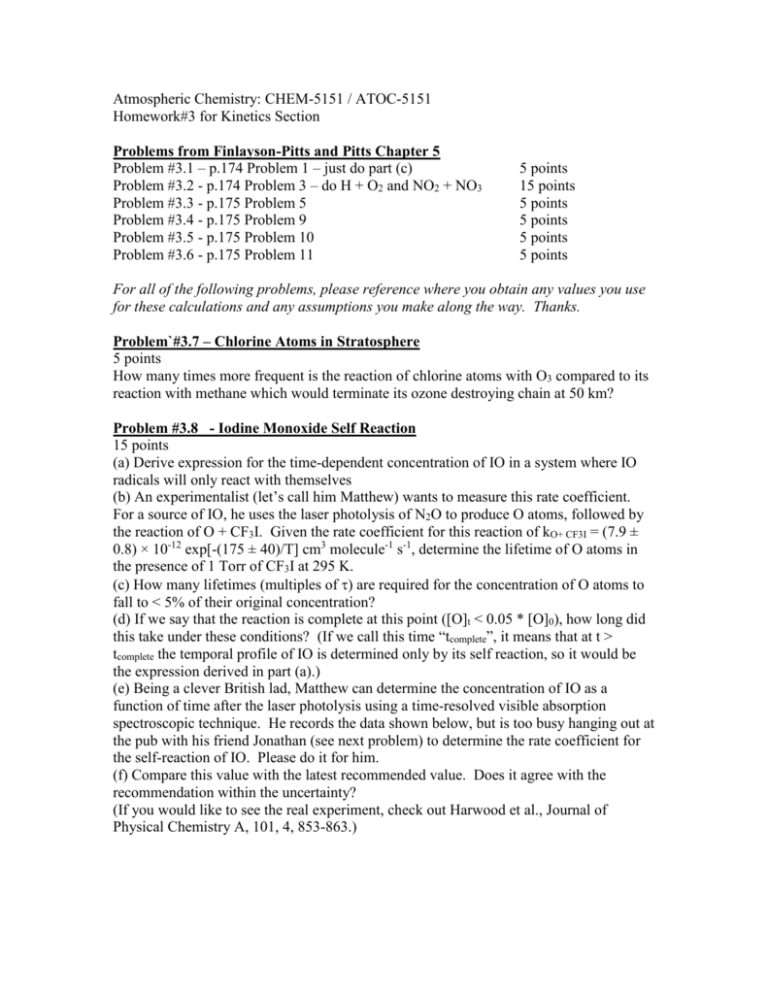
Atmospheric Chemistry: CHEM-5151 / ATOC-5151 Homework#3 for Kinetics Section Problems from Finlayson-Pitts and Pitts Chapter 5 Problem #3.1 – p.174 Problem 1 – just do part (c) Problem #3.2 - p.174 Problem 3 – do H + O2 and NO2 + NO3 Problem #3.3 - p.175 Problem 5 Problem #3.4 - p.175 Problem 9 Problem #3.5 - p.175 Problem 10 Problem #3.6 - p.175 Problem 11 5 points 15 points 5 points 5 points 5 points 5 points For all of the following problems, please reference where you obtain any values you use for these calculations and any assumptions you make along the way. Thanks. Problem`#3.7 – Chlorine Atoms in Stratosphere 5 points How many times more frequent is the reaction of chlorine atoms with O3 compared to its reaction with methane which would terminate its ozone destroying chain at 50 km? Problem #3.8 _- Iodine Monoxide Self Reaction 15 points (a) Derive expression for the time-dependent concentration of IO in a system where IO radicals will only react with themselves (b) An experimentalist (let’s call him Matthew) wants to measure this rate coefficient. For a source of IO, he uses the laser photolysis of N2O to produce O atoms, followed by the reaction of O + CF3I. Given the rate coefficient for this reaction of kO+ CF3I = (7.9 ± 0.8) × 10-12 exp[-(175 ± 40)/T] cm3 molecule-1 s-1, determine the lifetime of O atoms in the presence of 1 Torr of CF3I at 295 K. (c) How many lifetimes (multiples of ) are required for the concentration of O atoms to fall to < 5% of their original concentration? (d) If we say that the reaction is complete at this point ([O]t < 0.05 * [O]0), how long did this take under these conditions? (If we call this time “tcomplete”, it means that at t > tcomplete the temporal profile of IO is determined only by its self reaction, so it would be the expression derived in part (a).) (e) Being a clever British lad, Matthew can determine the concentration of IO as a function of time after the laser photolysis using a time-resolved visible absorption spectroscopic technique. He records the data shown below, but is too busy hanging out at the pub with his friend Jonathan (see next problem) to determine the rate coefficient for the self-reaction of IO. Please do it for him. (f) Compare this value with the latest recommended value. Does it agree with the recommendation within the uncertainty? (If you would like to see the real experiment, check out Harwood et al., Journal of Physical Chemistry A, 101, 4, 853-863.) Time seconds 0.0001 0.001 0.002 0.004 0.005 0.007 0.009 0.01 0.012 [IO] molecule cm-3 9.86E+11 8.3E+11 7.21E+11 5.63E+11 4.98E+11 4.14E+11 3.54E+11 3.41E+11 3.01E+11 Problem #3.9 – PAN Lifetime 20 points Over a friendly pint down at the pub, Matthew (from the last problem) makes a bet with his friend Jonathan (another British chap) that the lifetime of peroxy acetyl nitrate (PAN) at 10 km is determined by its reaction with OH. Jonathan scoffs and says that it is most definitely not so, and that it is the photolysis that controls PAN’s lifetime at that altitude. Their friend Karl (the only American in the group) offers up the slightly irrelevant piece of information that at the ground, the thermal decomposition controls the lifetime of PAN. In order to sort these fellas out, please calculate the lifetime of PAN with respect to thermal decomposition, photolysis, and reaction with OH at the surface, 5 km and 10 km. (If you would like to see how the UV photolysis and reaction with OH lifetimes were determined, see Talukdar et al., Journal of Geophysical Research, 100, D7, 1416314173, 1995.) Problem`#3.10 – O(1D) Relative Rate Coefficients 15 points The production rate of OH in the atmosphere is often dictated by the reaction: O(1D) + H2O 2 OH (1) This reaction is in direct competition with the quenching of O(1D) by nitrogen: O(1D) + N2 O(3P) + N2 (2) An experimentalist named Ed wants to measure the rate coefficient for the reaction of O(1D) + H2O, not once, but twice. He first measures k1 and k2 by an absolute technique and gets the following results: k1 = 2.0 × 10-10 cm3 molecule-1 s-1 k2 = 3.0 × 10-11 cm3 molecule-1 s-1 It turns out that his advisor, let’s call him “Ravi”, measured k2 way back in the olden days before they even used computers and got a value of k2 = 2.6 × 10-11 cm3 molecule-1 s-1. Ed and Ravi decide maybe they should not necessarily trust the numbers that Ravi got on his TI-80 calculator, so they decide to measure k2 by a relative technique. They have an instrument that measures the concentration of OH very well and design the following experiment: the photolysis of O3 is used to generate O(1D) in the presence of H2O and N2. Sufficient H2O concentrations are used such that reaction (1) occurs on a time scale much faster than the OH concentration can be followed, but the [OH] after reactions (1) and (2) have gone to completion can be determined. The [H2O] is kept constant and various amounts of N2 are added to the system in an attempt to discern the relative rate coefficients k1 and k2. The signals recorded and the conditions they were recorded under are listed below: (a) Derive an expression for the signal (S) that depends on the signal recorded in the presence of H2O but no N2 (S0), the rate coefficients k1 and k2, and [N2] and [H2O]. (b) If you take the measurement of k1 above as “correct”, describe how you could derive the value for k2 from this set of experiments. (c) What value for k2 do you get from the below data set? Is the new value of k2 confirmed by this relative method? (d) If the instrument can discern 2% changes in the [OH], would the experimenters be able to discern between the old and new versions of k2 under these conditions? (Note: If you would like to see more on how this was done, see Dunlea and Ravishankara. Physical Chemistry Chemical. Physics, 6 (13), 3333 - 3340, DOI: 10.1039/b402483d, 2004. Note that this new value for k2 was confirmed independently by two other research groups, see Ravishankara et al., Geophysical Research Letters, 29, 10.1029/2002GL014850, 2002.) [H2O] molecule cm-3 1.00E+17 1.00E+17 1.00E+17 1.00E+17 1.00E+17 1.00E+17 [N2] molecule cm-3 0 1.00E+18 2.00E+18 3.00E+18 4.00E+18 5.00E+18 OH Signal arbitrary units 2.00E+08 8.00E+07 2.00E+07 3.64E+06 5.19E+05 6.11E+04 Problem #3.11 – Gas and Liquid Phase Partitioning 5 points Consider a sample of air at room temperature and 1 atm is in equilibrium with a pool of water. If the mixing ratio of HNO3 in the gas phase is 1 ppm, what are the number densities of HNO3 in gas and aqueous phases? What about for O3 at 100 ppb in the gas phase?
